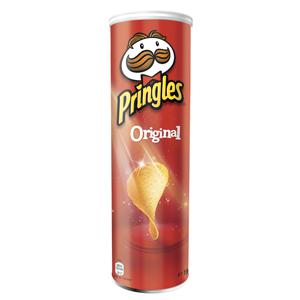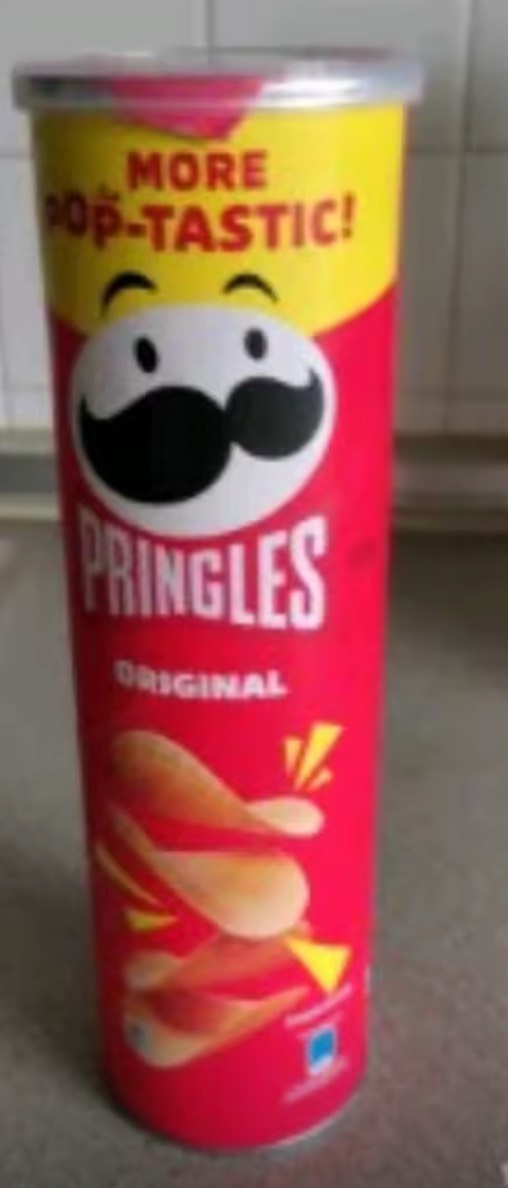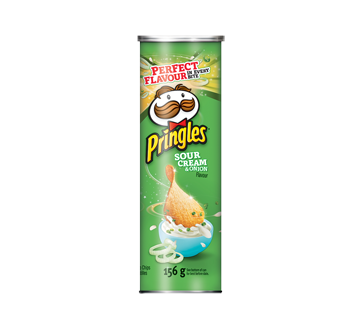Pringles
Brand’s Products

Pringles Original
My favourite potato chips. Not too oily and usually dont break as eaily as other brands. Easy to carry around. No need to finish all in one go as the ca...

Pringles Original
My favourite potato chips. Not too oily and usually dont break as eaily as other brands. Easy to carry around. No need to finish all in one go as the ca...

Pringles Original
Fried stuff loaded with chemicals. It tatstea great though- always end up eating these if served.

Pringles Original
Fried stuff loaded with chemicals. It tatstea great though- always end up eating these if served.

Pringles Original
A convenient snack to enjoy on the go or while watching Netflix. The original flavour is satisfyingly crunchy, perfectly balanced and not too salty. The c...

Pringles Original
A convenient snack to enjoy on the go or while watching Netflix. The original flavour is satisfyingly crunchy, perfectly balanced and not too salty. The c...

Pringles Original
Its always something to snack on while watching movies. The taste is classic enjoying every bite of the flakes is like an unquenchable desire for more. I l...

Pringles Original
Its always something to snack on while watching movies. The taste is classic enjoying every bite of the flakes is like an unquenchable desire for more. I l...

Pringles Original
Pringles potato chips are a classic, dependable snack with a signature crunch that’s instantly recognizable. The uniform, stackable shape makes them fun to...

Pringles Original
Pringles potato chips are a classic, dependable snack with a signature crunch that’s instantly recognizable. The uniform, stackable shape makes them fun to...

Pringles Original
Love the taste and texture of the chips. Won’t get too salty and you really can’t stop at 1 or a few pieces as it’s too irresistible.

Pringles Original
Love the taste and texture of the chips. Won’t get too salty and you really can’t stop at 1 or a few pieces as it’s too irresistible.

Pringles Original
It's a taste that we'll never forget as its MSG reaches our tastebuds and keeps you wanting for more! It's especially needed during your chillax times, che...

Pringles Original
It's a taste that we'll never forget as its MSG reaches our tastebuds and keeps you wanting for more! It's especially needed during your chillax times, che...

Pringles Original
My snacks for TV time and stock up every month to enjoy my me time


Pringles Original
Tasty and crunchy in a convenient airtight container for easy reach and storage. Reasonably priced and available in various sizes to suit all occasions.

Pringles Original
Tasty and crunchy in a convenient airtight container for easy reach and storage. Reasonably priced and available in various sizes to suit all occasions.

Pringles Original
Literally, once you pop you can't stop. This is my all-time favourite snacks.

Pringles Original
Literally, once you pop you can't stop. This is my all-time favourite snacks.

Pringles Original
This product brings on the flavour, the crunch and the taste all wrapped up in a nice container. It looks Just as good as it tastes and has a reasonable pr...

Pringles Original
This product brings on the flavour, the crunch and the taste all wrapped up in a nice container. It looks Just as good as it tastes and has a reasonable pr...

Pringles Original
I love how crisp and flavorful each chip is. The packaging keeps it fresh and it’s the perfect snack for any occasion.

Pringles Original
I love how crisp and flavorful each chip is. The packaging keeps it fresh and it’s the perfect snack for any occasion.

Pringles Original
My all time favorite chips! Ever since I was a child up until now I always ate this chips

Pringles Original
My all time favorite chips! Ever since I was a child up until now I always ate this chips

Pringles Original
Losing alot on taste and texture, having better ones by other brands




Pringles Original
The chips are crispy and great taste. Have been eating for many times and this is still my favourite snacks.

Pringles Original
The chips are crispy and great taste. Have been eating for many times and this is still my favourite snacks.

Pringles Original
Still this brand the best. We have been seat since childhood and the original still the best. Young and old folks all love it

Pringles Original
Still this brand the best. We have been seat since childhood and the original still the best. Young and old folks all love it

Pringles Original
The crispy taste and light snacking potato taste make me and my family wanting more. We bring it whenever we went for a picnic or even at family event

Pringles Original
The crispy taste and light snacking potato taste make me and my family wanting more. We bring it whenever we went for a picnic or even at family event

Pringles Original
My favourite potato chips. Not too oily and usually dont break as eaily as other brands. Easy to carry around. No need to finish all in one go as the ca...

Pringles Original
My favourite potato chips. Not too oily and usually dont break as eaily as other brands. Easy to carry around. No need to finish all in one go as the ca...

Pringles Original
A convenient snack to enjoy on the go or while watching Netflix. The original flavour is satisfyingly crunchy, perfectly balanced and not too salty. The c...

Pringles Original
A convenient snack to enjoy on the go or while watching Netflix. The original flavour is satisfyingly crunchy, perfectly balanced and not too salty. The c...

Pringles Original
Pringles potato chips are a classic, dependable snack with a signature crunch that’s instantly recognizable. The uniform, stackable shape makes them fun to...

Pringles Original
Pringles potato chips are a classic, dependable snack with a signature crunch that’s instantly recognizable. The uniform, stackable shape makes them fun to...

Pringles Original
Love the taste and texture of the chips. Won’t get too salty and you really can’t stop at 1 or a few pieces as it’s too irresistible.

Pringles Original
Love the taste and texture of the chips. Won’t get too salty and you really can’t stop at 1 or a few pieces as it’s too irresistible.

Pringles Original
This product brings on the flavour, the crunch and the taste all wrapped up in a nice container. It looks Just as good as it tastes and has a reasonable pr...

Pringles Original
This product brings on the flavour, the crunch and the taste all wrapped up in a nice container. It looks Just as good as it tastes and has a reasonable pr...

Pringles Original
I love how crisp and flavorful each chip is. The packaging keeps it fresh and it’s the perfect snack for any occasion.

Pringles Original
I love how crisp and flavorful each chip is. The packaging keeps it fresh and it’s the perfect snack for any occasion.

Pringles Original
My all time favorite chips! Ever since I was a child up until now I always ate this chips

Pringles Original
My all time favorite chips! Ever since I was a child up until now I always ate this chips

Pringles Original
Still this brand the best. We have been seat since childhood and the original still the best. Young and old folks all love it

Pringles Original
Still this brand the best. We have been seat since childhood and the original still the best. Young and old folks all love it

Pringles Original
The crispy taste and light snacking potato taste make me and my family wanting more. We bring it whenever we went for a picnic or even at family event

Pringles Original
The crispy taste and light snacking potato taste make me and my family wanting more. We bring it whenever we went for a picnic or even at family event

Pringles Original
I enjoyed it as a kid and now my kids love it. So difficult to stop munching these. We never get bored of this flavour

Pringles Original
I enjoyed it as a kid and now my kids love it. So difficult to stop munching these. We never get bored of this flavour

Pringles Original
It is a reliable brand if you want to satisfy a chips craving. It is tasty and feels healthier since it is baked.

Pringles Original
It is a reliable brand if you want to satisfy a chips craving. It is tasty and feels healthier since it is baked.



Pringles Original
All time favourite flavour, can never go wrong with this. Consistent taste and packaging.

Pringles Original
All time favourite flavour, can never go wrong with this. Consistent taste and packaging.



Pringles Original
My go to chips during road trip due to its packaging and also love the taste. Everyone favorite chips.

Pringles Original
My go to chips during road trip due to its packaging and also love the taste. Everyone favorite chips.

Pringles Original
My kids has always love pringles snacks and would munch non stop !!


Pringles Original
These pringle products never disappoint always on point ,the taste always original

Pringles Original
These pringle products never disappoint always on point ,the taste always original

Pringles Original
Classic Pringles never fail! Childhood favorite. Cheat day essential


Pringles Original
Hi this is junk food. We need to move away from this kind of food if we we want to be healthy.

Pringles Original
Hi this is junk food. We need to move away from this kind of food if we we want to be healthy.

Pringles Original
very very very bad, quality dropped since they decided to cut busines with Russia and cook that F*cked up s*it in most poison country in the world... qu...

Pringles Original
very very very bad, quality dropped since they decided to cut busines with Russia and cook that F*cked up s*it in most poison country in the world... qu...

Pringles Original
Pringles Original delivers a unique, engineered perfection. ultra-crispy, fun to eat, and great for travel or sharing. It’s not a replacement for real pota...

Pringles Original
Pringles Original delivers a unique, engineered perfection. ultra-crispy, fun to eat, and great for travel or sharing. It’s not a replacement for real pota...

Pringles Original
Pringles is much too salty and does not taste good as the chips are too thin and so break easily into crumbs and too salty. The flavour is also too bland

Pringles Original
Pringles is much too salty and does not taste good as the chips are too thin and so break easily into crumbs and too salty. The flavour is also too bland

Pringles Original
This is so yummy I like it since I was kid it's my favorite snacks


Pringles Original
Losing alot on taste and texture, having better ones by other brands




Pringles Original
Just salty tbh not much flavour. Sure has a crunch but…that’s all sadly


Pringles Original
I don't very like this kind of chips, because they're very dry and taste like nothing 🥲

Pringles Original
I don't very like this kind of chips, because they're very dry and taste like nothing 🥲

Pringles Original
Están ricas pero ofu no sabes el dineral que te dejas por unas patatas




Pringles Original
I used to love PRINGLES ORIGINAL but now there are so many other innovative brands in the market, PRINGLES did not manage to maintain the quality. The com...

Pringles Original
I used to love PRINGLES ORIGINAL but now there are so many other innovative brands in the market, PRINGLES did not manage to maintain the quality. The com...

Pringles Original
price has increased. and this potato chips is not slices of potato but it is mashed potato and then moulded and sliced . Salt content is high. I prefer ...

Pringles Original
price has increased. and this potato chips is not slices of potato but it is mashed potato and then moulded and sliced . Salt content is high. I prefer ...

Pringles Original
tasteless almost chips unevenly cut & dried so uniform it's like eating rubber, just thinner & crispier

Pringles Original
tasteless almost chips unevenly cut & dried so uniform it's like eating rubber, just thinner & crispier

Pringles Original
An absolute let down!!!
Too salty and not crispy at all!!!
Totally different from the Pringles of before!!!

Pringles Original
An absolute let down!!!
Too salty and not crispy at all!!!
Totally different from the Pringles of before!!!

Pringles Original
Taste is pretty normal for an original potato chip. Much prefer the other flavours of Pringles (sour cream, etc).

Pringles Original
Taste is pretty normal for an original potato chip. Much prefer the other flavours of Pringles (sour cream, etc).

Pringles Original
Always stock this at home as my every drinking night's snack 🤭 not too salty and the thickness is just nice

Pringles Original
Always stock this at home as my every drinking night's snack 🤭 not too salty and the thickness is just nice

Pringles Original
not sure why, but i feel like the taste is not as good as last time. to add, the amount of pringles given per container has also reduced quite a fair bit...

Pringles Original
not sure why, but i feel like the taste is not as good as last time. to add, the amount of pringles given per container has also reduced quite a fair bit...


























